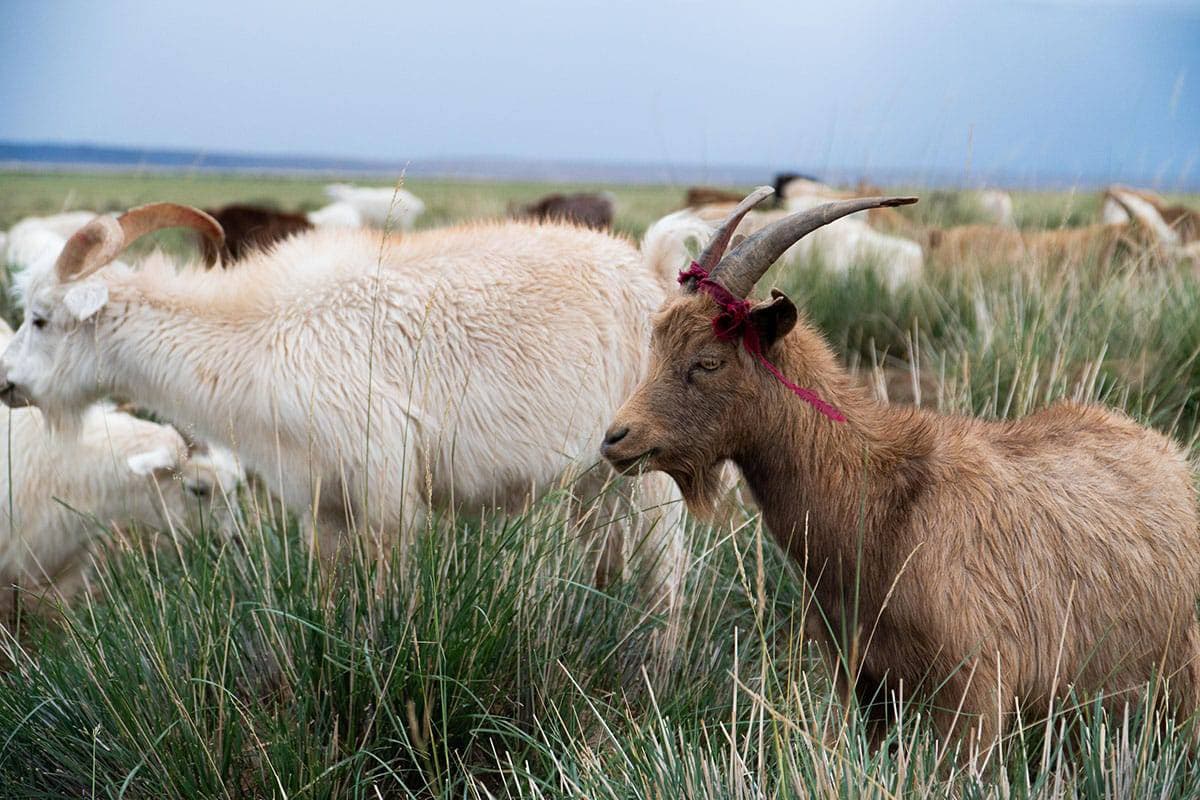FAQs About Mongolian Cashmere
What is cashmere?
Cashmere is the lovely fiber that is found on the underside of a goat’s belly. In order to insulate the animal from harsh conditions, it grows into fine strains that turn into a soft, dense, downy fleece as winter comes on. Because of the bitterly cold winters unique to Mongolia, the goats there grow the world’s highest quality cashmere.
In early spring, herders comb the loose fiber from their goats when they start to shed and harvest their cashmere wool. Since the cashmere is taken as the goat is shedding its coat, the process doesn’t harm them or leave them vulnerable to the cold weather.

What is good quality cashmere?
Most important to cashmere fiber quality is the fiber length and fiber thickness. In order to be considered cashmere in the first place, the fibers brushed off of goats must be no more than 30 microns wide. As fibers get thinner, all things being equal, the fiber will become softer and more luxurious.
Fiber length is also just as important. When made into clothes, longer fibers will have a higher tensile strength, hold knits better, and lead to higher product durability. The longer the fibers are, the less your clothes will stretch out of shape, which is a common issue with poor quality cashmere. Cashmere clothes with short fiber lengths will also easily shed fibers and pill, yet another common gripe with cashmere. All things being equal, longer fiber lengths are going to lead to a more durable, lasting product.
The highest, “Grade A” cashmere has a fiber length of 34mm-36mm. The Mongolian cashmere fiber that ULA+LIA uses has an average length of around 43mm. As you would guess, this gives our yarn incredible dexterity and longevity.
With thin micron diameters and its exceptionally long fiber length of over 40mm, our yarn mixes the traditional soft and luxurious feel of cashmere with incredible durability and build quality that is so hard to find in cashmere clothes.

Is softness important?
Cashmere is supposed to be soft, and quality cashmere will always have a lovely feel. However, just because an item is softer than another doesn’t imply better quality, and sometimes actually means the opposite.
For instance, an item made of single ply cashmere yarn will be softer than an item with double ply yarn, but will pill, and lose its shape much faster. A properly spun yarn with a tighter twist will also tend to not be as soft as a poorly spun yarn, but again, the durability and quality will be higher. After flirting the line of being a bit overspun in previous years, we’ve reduced twist slightly to keep a durable item but also retain the incredible softness that cashmere is known for.
Also, all things being equal, a shirt that is denser with a higher stitch count is actually not going to be as soft as a thin shirt with a lower stitch count. The denser item, however, is not going to stretch as much, be warmer, and last longer. It will also soften more as it breaks in, which is a beautiful thing about quality cashmere; it’s actually going to get more supple the more you wear it.

How is ULA+LIA cashmere made?
The process of creating your Mongolian cashmere knitting and crocheting yarn started around April when raw Mongolian cashmere was selected to create this unique batch of yarn. The raw cashmere was separated from rough guard hairs, thoroughly washed, and then dyed to its final colors.
Through September, our knitting yarn was spun, packaged, and sent directly for sale. Think of ULA+LIA as farm to table, but for Mongolian cashmere! Because of the freshness, and not being used in stores, sometimes the cashmere fibers can retain some of their natural smell. After being worked for a bit, the natural scent will dissipate. The yarn will also still have some residual oil from the spinning process, so giving the finished item a good bath with these directions will remove the oil and give a lovely final extra dose of softness to your item as well. If you prefer, you can also bulk wash the skeins before knitting.

How should I wash cashmere?
You don’t need to be afraid to clean quality cashmere pieces! Regular cleaning will actually help extend its life by keeping away moths. Dry cleaning is the easiest, but gentle hand washing with a delicate soap is ideal. Afterwards, press out the excess water, but do not wring out the clothes. Lay the item flat on the towel and reshape it as it dries. Fold items when storing.
More questions? Feel always feel free to write to info@ulaandlia.com, follow us on Instagram, Facebook, or ask questions in our ravelry group!